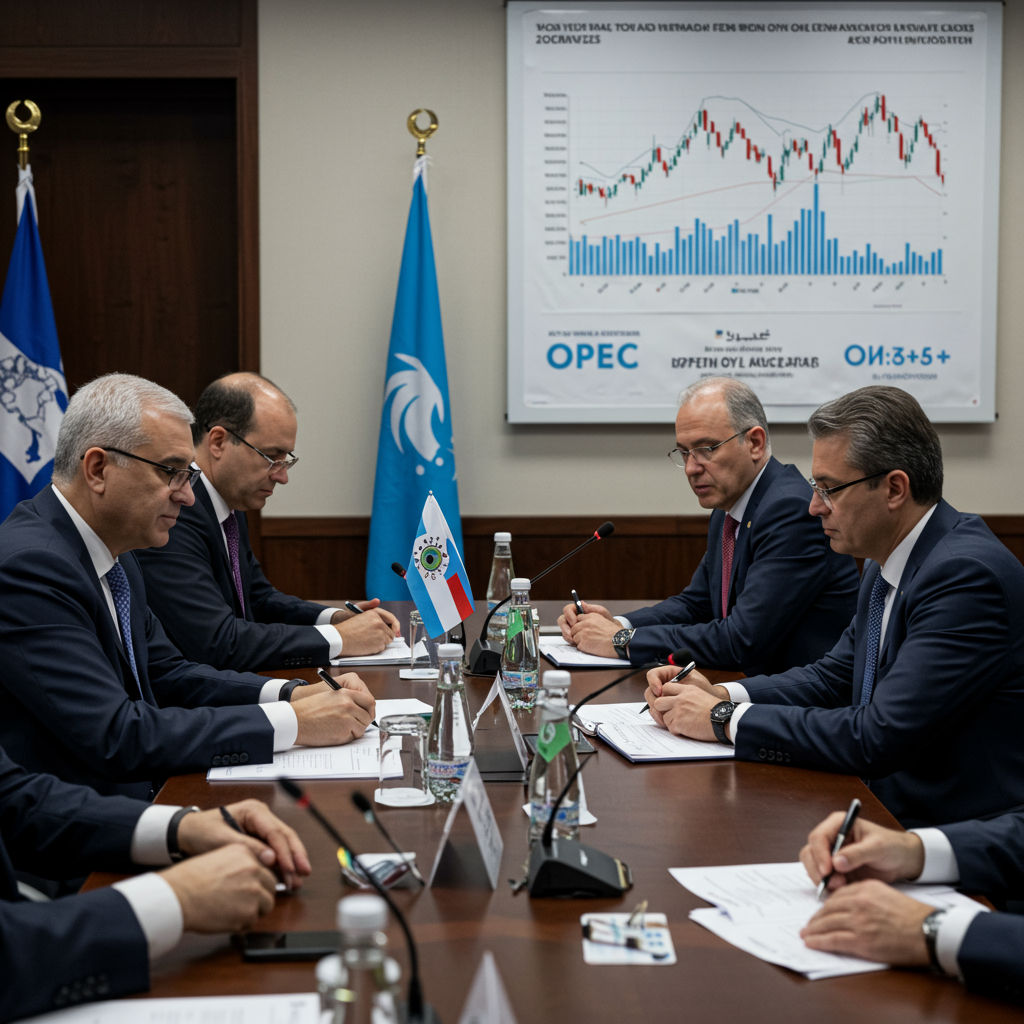The global oil market is witnessing a significant strategic pivot as OPEC+, the alliance of oil producers led by Saudi Arabia and Russia, has announced plans to dramatically accelerate its supply increases. Moving faster than previously anticipated, the group has agreed to a substantially larger output hike for August 2025, signaling a renewed focus on market share over strict price defense. This decision is poised to inject a substantial amount of crude into the market sooner than expected, with complex implications for prices, producers, and the wider energy landscape.
OPEC+’s Accelerated Production Plan Unveiled
In a move that surprised many market observers, OPEC+ members have committed to a notably steeper increase in oil production for August. Following recent virtual discussions, eight key nations within the alliance have agreed to boost supply by approximately 548,000 barrels per day (b/d). This figure represents a significant step up from the 411,000 b/d monthly increases that were implemented for May, June, and July, already three times faster than the group’s original roadmap. Traders had largely expected the August increase to maintain the pace set in previous months.
This accelerated schedule is part of a broader strategy shift. The alliance is now on track to return 2.2 million b/d of previously curtailed production to the market by September 2025. This timeline is remarkably aggressive, completing the unwinding of their most recent output cuts a full year ahead of the initial schedule outlined by the group. The decision highlights a clear intention to react swiftly to market dynamics and capitalize on perceived opportunities.
Doubling Down on Supply
The commitment to a larger August hike underscores OPEC+’s determination to rapidly ramp up output.
This new increase builds upon the cumulative supply additions already put in place since April.
The collective effort aims to restore significant volumes to global supply chains well before year-end.
Why the Sudden Pivot in Strategy?
Several factors appear to be driving OPEC+’s dramatic shift towards increasing supply faster. A key immediate motivation is to leverage the strong demand typically seen during the northern hemisphere summer months. Evidence suggests robust consumption, with US refiners reportedly processing crude at levels not seen since 2019 for this time of year, contributing to rising prices for certain refined fuels like diesel. OPEC+ aims to meet this peak demand and potentially regain market share.
Beyond the short-term gain, delegates and analysts point to longer-term strategic goals. A major driver is the ambition to reclaim market share previously ceded to competing producers, particularly US shale drillers, whose output has grown significantly. By increasing supply, OPEC+ can exert pressure on higher-cost producers. Additionally, some reports suggest the accelerated pace is intended to put pressure on member countries that have historically exceeded their production quotas, potentially forcing them to compensate for past over-production by foregoing their share of the new increases. Saudi Arabia, a key player in the alliance, is noted as being particularly eager to restart idled capacity quickly.
Shifting Focus: Market Share Over Price Defense
Analysts view this move as a clear transition from a “price defense” strategy, which aimed to support oil prices through supply cuts, to a “market share” approach.
This shift signifies a willingness to potentially accept lower prices in exchange for higher sales volumes and increased market presence.
The strategic recalibration reflects the evolving competitive landscape in the global energy market.
Potential Market Implications and Outlook
While the accelerated supply increase addresses immediate summer demand, it is happening in a market environment widely predicted to face significant oversupply later in 2025. Forecasts from organizations like the International Energy Agency and major financial institutions such as JPMorgan and Goldman Sachs anticipate a substantial market surplus in the fourth quarter. Some projections even suggest oil prices could fall towards $60 a barrel or potentially lower by year-end.
The emerging surplus is fueled by multiple factors. Alongside the planned OPEC+ increases, production is rising from non-OPEC+ sources, including the US, Guyana, Canada, and Brazil. Meanwhile, global oil inventories have reportedly been accumulating at a rate of around 1 million barrels a day in recent months, partly due to cooling consumption in key regions like China. Geopolitical tensions, such as the recent Iran-Israel conflict, provided only a brief, contained price boost as supply remained undisrupted.
A Looming Supply Glut?
The combination of accelerated OPEC+ supply and rising non-OPEC+ output points towards an increased likelihood of a significant build-up in global oil stocks.
This potential inventory swelling could exert downward pressure on crude oil prices in the latter part of the year.
Market focus appears to be shifting towards this supply-side dynamic, eroding the premium from geopolitical risks.
Challenges and Compliance Hurdles Ahead
The decision to accelerate supply increases, while strategically motivated, presents notable challenges for OPEC+ members. Key producers like Saudi Arabia must navigate the delicate balance between the benefits of selling higher volumes and the potential negative impact of falling prices on their national revenues. Saudi Arabia, for instance, is already grappling with a significant budget deficit and has had to implement spending cuts on major development projects.
Russia, another critical member of the alliance, also faces economic pressures, including a challenging economic outlook and potential banking sector instability exacerbated by the ongoing conflict in Ukraine. Lower oil prices would further strain its finances.
Moreover, there is the persistent challenge of compliance within the group. Despite announced increases, the actual boost to market supply may be less than stated. Some members have a history of producing above their quotas. Saudi Arabia is reportedly pressing countries like Kazakhstan, a notable over-producer, to compensate for past excesses. Such compensation efforts could temper the actual amount of new oil entering the market.
Impact on Non-OPEC+ Producers
The prospect of lower prices also poses difficulties for producers outside the alliance. The US shale industry, which competes directly with OPEC+, is already feeling the effects. Recent surveys indicate that US shale executives anticipate drilling significantly fewer wells in 2025 than initially planned. They cite lower oil prices and lingering uncertainty from trade policies as key factors influencing their investment decisions.
Frequently Asked Questions
What is the specific OPEC+ oil production increase for August 2025?
For August 2025, OPEC+ has agreed to a larger-than-expected oil production increase of approximately 548,000 barrels per day (b/d). This figure is significantly higher than the 411,000 b/d monthly increments implemented from May through July, signaling a faster pace of supply restoration than anticipated by many market analysts and traders.
Why is OPEC+ suddenly boosting supply faster?
OPEC+’s decision to accelerate supply increases is driven by multiple factors. Primarily, they aim to capitalize on strong northern hemisphere summer demand. Strategically, the group is shifting towards a “market share” focus, seeking to regain ground lost to competitors like US shale producers. The move also potentially serves to pressure members who have over-produced against their quotas.
How might this accelerated supply hike affect future oil prices?
While the increase addresses immediate demand, the accelerated supply, coupled with rising non-OPEC+ production and cooling global consumption trends, is widely expected to lead to a market surplus later in 2025, particularly in the fourth quarter. This potential surplus could exert downward pressure on oil prices, with some forecasts suggesting prices could fall towards $60 a barrel or lower.
Conclusion
OPEC+’s decision to implement a significantly larger oil supply increase in August 2025 marks a notable acceleration in its strategy. By boosting output by 548,000 b/d, the alliance is signaling a clear pivot towards reclaiming market share and capitalizing on immediate summer demand, moving away from a long-standing price defense posture. While the move aims to restore production volumes rapidly, completing the unwind a year early, it also increases the likelihood of a global market surplus later in the year. This outlook presents both opportunities and challenges, potentially pleasing consumers and governments seeking lower energy costs while creating financial pressure for producers within and outside the alliance as they navigate the complex balance of supply, demand, and price stability in an evolving energy landscape.
Word Count Check: 945




